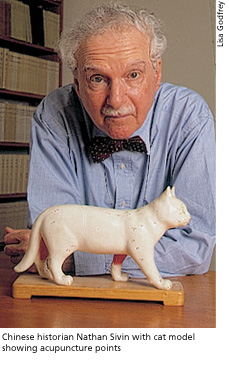
The Body in Balance
Chinese Historian Diagnoses the Yin and Yang of Health and Illness

I woke up one morning, got out of bed, and fell flat on my face,”
recalls Nathan Sivin, a professor of Chinese history. He was visiting
the Needham Research Institute in Cambridge, England, at the time, where
he goes most summers to do research on Chinese science and civilization.
“I stood up and fell flat on my face again,” he continues,“and
I remember thinking, ‘If this is permanent, it’s going to be
terribly inconvenient.’”
Sivin is telling the story to illustrate how frightening the experience of illness can be, especially a sudden and inexplicable onset. “I had no way of knowing whether this was the end of my active life,” he says. It wasn’t. The imbalance, a doctor later told him, was from a virus, and he should be back to the institute’s ancient Chinese texts in about 48 hours.
Because he teaches in a number of departments and programs at Penn, Sivin calls himself a scholarly dilettante. His appointment is in the department of the History and Sociology of Science, but he is also an honorary professor in the Chinese Academy of Sciences and an advisor to the Academy of Traditional Chinese Medicine, both in Beijing.
“One of the great powers of any kind of healing is the power to explain,” he says, “the power to take a disorienting experience and to impose order on it.” But what counts as an explanation for a distressing symptom in one culture—a virus—means nothing to a stricken person whose mindset has no place for the germ theory of disease. “Even though we all have the same physical body,” he asserts, “there is nothing else universal about it.”
 Unlike
Western views of anatomy, traditional Chinese medicine does not look at
the body as a biomedical machine whose broken parts need to be located
and then repaired or replaced to restore health. Instead, he says, the
Chinese have long regarded the whole person as an integral part of the
larger cosmos. Classical medical texts talk about healing as restoring
an ecology of physiological, emotional, and moral balance in unity with
social relations and the natural cycles of heaven and earth. “It’s
a language of processes rather than structures and tissues and organs.”
Unlike
Western views of anatomy, traditional Chinese medicine does not look at
the body as a biomedical machine whose broken parts need to be located
and then repaired or replaced to restore health. Instead, he says, the
Chinese have long regarded the whole person as an integral part of the
larger cosmos. Classical medical texts talk about healing as restoring
an ecology of physiological, emotional, and moral balance in unity with
social relations and the natural cycles of heaven and earth. “It’s
a language of processes rather than structures and tissues and organs.”
In the Chinese model, the human body takes in food and air, and distributes their life-giving substance throughout. The vital energy it feeds, called ch’i, flows through all things, making life happen. Ch’i enlivens the body and animates change, ushering day into night, spring into summer, youth into maturity. When ch’i dissipates, death happens; when the rhythm of its flow becomes unbalanced, sickness ensues.
“If you’re thinking about illness as a matter of imbalance,” Sivin explains, “then you need an analytical language for talking about balance and imbalance. That’s what yin and yang and the Five Phases are.”
If someone complained of feeling hot sensations, for instance, a traditional Chinese healer might prescribe an herbal remedy or acupuncture regimen to cool down the ch’i and restore the balance. “One yin and one yang are called the Way,” wrote Hui-tsung, an emperor and amateur physician. “Bias toward yin or bias toward yang is called disease.” To deal with imbalances more complicated than night-and-day polarities, healers might invoke the Five Phases, similar to humoral medicine, the norm for Western medical science from the 4th century B.C. until the late 19th century.
Modern medicine excels at techniques that intervene in trauma and aggressively treat acute or infectious illnesses. “The strength of classical Chinese medicine,” Sivin points out, “lay in its treatment of chronic disorders—its sophisticated analysis of how functions were related on many levels, from the vital processes of the body to the emotions to the natural and social environment of the patient—always with therapy in mind.”
It’s a holistic and patient-centered approach to healing that could help balance the alienating features of today’s health care industry, which are driving dissatisfied Americans to experiment with alternative remedies. “The Chinese have an old term for medicine,” Sivin remarks, “the Art of Benevolence. [Western] doctors have used science as a kind of advertising slogan and a source of techniques for 300 years, but the fact is that what they’re doing is still a matter of caring for people. If they can’t do that, their knowledge doesn’t count for anything.”